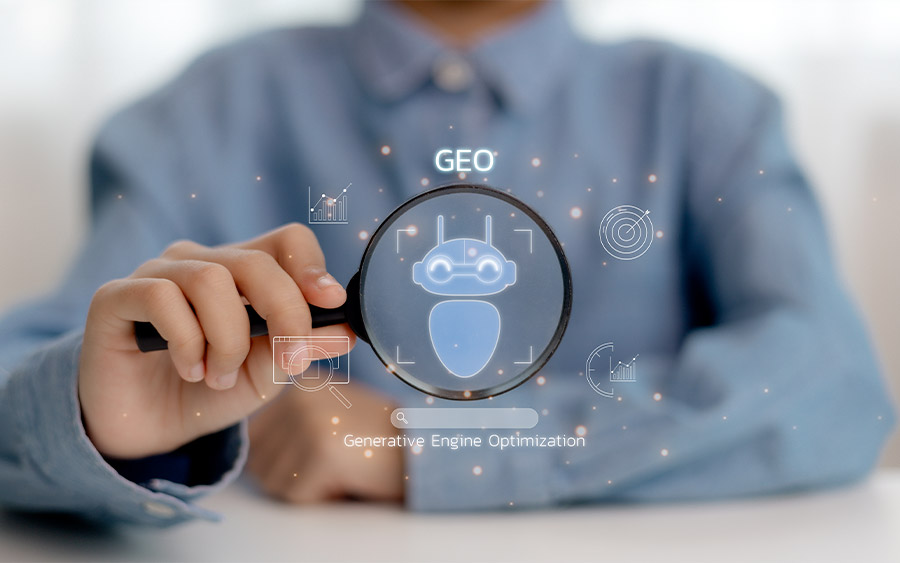Generative Engine Optimization (GEO): The Future of SEO?
AI is disrupting SEO as we knew it. With the arrival of search engines using artificial intelligence to generate responses, it becomes crucial to optimize your content differently. This is where Generative Engine Optimization (GEO) comes in.

What does it consist of? How to adopt Generative Engine Optimization (GEO) to ensure optimal visibility? We explain everything in this article.
What is Generative Engine Optimization (GEO)?
Generative Engine Optimization is an approach that aims to optimize content for AI-based search engines, such as Google SGE (Search Generative Experience) or Bing Chat.
Unlike classic SEO – which targets traditional web pages and referrals – GEO focuses on the ability of content to be understood and integrated by generative AI.
Why is this important? Because these engines no longer just reference content, they reinterpret and reorganize it. If your content isn’t designed to be picked up properly, it may lose visibility.
How does GEO work?
Generative Engine Optimization is based on content optimization for generative search engines, i.e. AIs that provide complete answers written from multiple sources.
Unlike traditional SEO, which aims to position itself well on Google and other classic engines, GEO seeks to make content understandable, relevant and usable by conversational AI.
Here are the key steps in how GEO works.
Understanding AI Indexing
Generative AIs, such as Google SGE (Search Generative Experience) or ChatGPT, do more than just display a list of results. They analyze and reformulate content to give synthetic and structured answers.
Structure content for AI-friendly reading
Generative engines place a high value on the clarity and structure of the content; They appreciate:
- the use of explicit headings and subheadings (H1, H2, H3…),
- the division into short and airy paragraphs ,
- the presence of bulleted lists and tables to summarize the information,
- the definition of key concepts at the beginning of the paragraph.
Focusing on Expertise and Authority (EEAT)
Google and other AIs favor content from trusted sources. The GEO therefore highlights EEAT (Expertise, Experience, Authority, Reliability) with:
- the integration of verifiable and recent sources,
- the presence of recognized and identifiable authors (name, bio, professional links),
- the highlighting of case studies, figures and testimonies to give credibility to the information.
Use natural and relevant language
AI engines analyze the tone, fluency, and accuracy of content. To be properly interpreted:
- write in a fluid, natural and conversational way,
- avoid sentences that are too complex or too vague,
- Use contextual keywords rather than just keyword stuffing.
Foster interaction and engagement
Generative AI promotes content that engages users ; We are talking about here:
- Integration of questions and answers (FAQs),
- the presence of interactive content (videos, infographics, carousels),
- and precise answers to Internet users ‘ search intentions .
GEO is therefore an evolution of SEO, adapted to the search engines of tomorrow! It’s no longer just about reaching the first page of Google, but about becoming a trusted reference source for generative AIs.
GEO vs SEO: what are the differences?
| Criterion | Classic | GEO | Summarized explanation |
| Objective | page referencing | Integration into AI | SEO aims to position pages on Google, while GEO optimizes content to be picked up and synthesized by AI. |
| Keywords | Primordial | Important but contextualized | SEO is based on specific keywords, while GEO focuses on the overall understanding of content by AI. |
| Content | Optimized for Google | Understandable by AI | GEO content should be structured and worded in a way that is easily actionable by artificial intelligence. |
| User | Ranking | Essential | In GEO, a good user experience improves the interpretation and rendering of content by AI. |
How to optimize your content for GEO?
Produce original and useful content: AI promotes in-depth and original content.
- Integrate a logical structure : prioritize information with relevant headings and lists.
- Use natural language : write as you speak, without overloading with keywords.
- Multiply formats : integrate images, videos and tables to enrich the content.
- Update your content regularly : AIs like freshness and up-to-dateness.
The impact of GEO on the user experience
Generative Engine Optimization is not limited to optimizing for AI engines. It also plays a key role in improving the user experience (UX).
By providing relevant, engaging and accurate content, GEO allows companies to capture and hold the attention of Internet users. Smooth navigation and quick responses to queries drive engagement and increase conversion.
GEO and scalable content strategies
AI-generated content is rapidly evolving.
To stay relevant, it’s essential to have content strategies in place that are tailored to GEO. This includes :
- the use of intelligent prompts ,
- the adjustment of the generated responses,
- and the integration of human supervision to ensure impeccable quality.
Human expertise remains irreplaceable to provide:
- an emotional touch,
- a nuance,
- and added value that AI alone cannot provide.
GEO and artificial intelligence: beware of excesses
While AI allows you to create content quickly, you shouldn’t fall into the trap of being 100% automated.
AIs like ChatGPT or Gemini are very powerful, but they do not replace human expertise in writing. What for?
- A lack of nuance and originality : AIs gather existing information but do not create new ideas.
- An absence of emotion and storytelling : AI content can seem cold and impersonal.
- Risks of factual errors : AI can hallucinate data or invent facts.
- A danger for SEO in the long term : Google can penalize poorly optimized 100% AI content.
The right compromise? Use AI to structure content more efficiently, while preserving human expertise for writing and personalizing text.